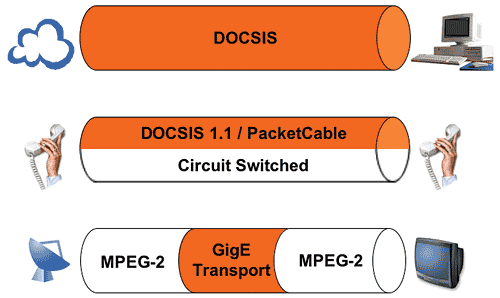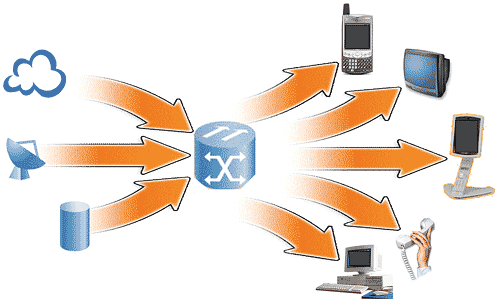Everything over IP
Internet protocol (IP) has revolutionized the provision of content and services over networks. Wherever the technology is implemented, innovation follows as communications become more efficient, services become more manageable, and access becomes more widespread. Contrast many of today’s typical experiences with those of just a decade ago. Contracts travel between coasts or even countries in an instant, thorough coverage is immediately available while news is breaking, and photographs are shared with friends and family soon after being taken. Current limitations While these innovations surely enrich our lives, further consideration reveals that they are largely restricted to static media content. But the last several years have seen more advanced users begin to extend IP technology use to audio and voice experiences. Video in particular remains largely on the fringes of widespread IP consumption, save for the occasional inter-office exchanges of notorious clips such as Steve Ballmer stalking across a stage exclaiming the virtues of "developers" or that guy descending from a slap on the side of the monitor to a brutal assault on his computer’s central processing unit (CPU). Most IP video consumption is limited to PCs as viewing devices and tends to be short, grainy and constrained to a small portion of the screen. These characteristics reveal much of why IP has yet to extend broadly from the data-oriented Web and email applications to mainstream video and voice. For those services to take off, they require the high reliability expected when a person picks up the phone and sufficient network quality of service (QoS) to ensure real-time delivery. Lack of QoS has little consequence for most data applications. Should a packet be delayed or re-routed, the fraction of a second latency in an email’s arrival is not really noticeable. But in the algorithmic build of a video or audio stream, packet-timing mishaps can break down delivery and quickly redirect the consumer to the tried-and-true mechanisms they’ve long used for those media. Another common reservation to IP technologies is their largely being constrained to PC consumption. For years, living rooms have been designed with TV sets as their centerpieces to facilitate relaxed and communal video experiences. And practically everyone has a device connected to the public switched telephone network (PSTN), used to communicate with others in the same situation, so there are high hurdles to making a change, especially if it imposes similar efforts on correspondents. Evolving standards and practices The broadband business faces these hurdles while also needing voice and video in order to fulfill the promise of ever-rising consumption of richer content. Because of this, standards and practices have been evolving from the requirements for text and photography to the high QoS or multi-megabit-per-second access to support IP delivery of real-time media. Voice over IP (VoIP) is beginning to rise particularly rapidly, with widespread implementations across the cable industry. As mentioned earlier, this development first required advances in service reliability, QoS and access to more devices, including communications with conventional telephones. In the case of cable, the industry tackled the QoS challenges required for VoIP with the PacketCable elements of Data Over Cable Service Interface Specification (DOCSIS) 1.1 and higher upstream per-channel throughput speeds in DOCSIS 2.0. Network infrastructure has matured with inclusion of automated redundancy elements that re-route whenever faults are encountered in order to approach the lifeline reliability standards associated with voice service. While network advances ensure the reliable delivery of high quality voice content, parallel developments enable service availability to any device. Media adapters allow functionally conventional phones to connect to always-on cable modems. Gateways and softswitches in the network interface to the PSTN so that the VoIP user can communicate with anyone desired. True to its IP basis, VoIP is spurring service innovations beyond just greater economic and bandwidth efficiencies in delivery of the service. New features are emerging to distinguish the service from plain old telephone service (POTS), such as unified messaging and call recording. And there is clearly room for even more functionality, especially as video joins the trend and true "everything over IP" is established. As the Internet’s popularity began, video was still an all-analog service. The rise of satellite offerings and the onset of digital cable have since changed that. But these services have been delivered by customized technologies because IP lacked the required controls for high quality video experiences. The rise of GigE During the last several years, IP has quietly begun impacting mass market video service delivery. Gigabit Ethernet (GigE) increasingly is utilized as the most economical and efficient means of transporting video content between facilities. (See Figure 1.) The catalyst for this has been the onset of de-jittering algorithms that implement the proper timing between packets—without those algorithms, video would arrive at its destination without the required synchronization for clean and reliable play. GigE is also supporting service innovations such as mechanisms to trace the availability and quality of every single program and automatically switch to an alternate source at the onset of any problems. Local advertising servers are beginning to utilize GigE as their primary interface, which enhances their scalability and enables them to simultaneously insert multiple advertisements that can be delivered to different zones within a cable system, according to demographic tendencies. The impact of GigE on the transport of video services is tremendous, but it literally terminates at the edge location of a cable system headend or hub, beyond which the content is converted for standard delivery to conventional TV sets and set-top boxes. Similar advantages to VoIP can be realized for video services through a clear path of continuing innovation. Advanced coding Plans for the realization of end-to-end IP video services are expected to hinge on the adoption of advanced video coding (AVC) practices such as MPEG-4 and VC-1. These techniques can double the bandwidth efficiency of programming relative to the MPEG-2 techniques used today. They can further extend video service availability from set-top boxes and TV sets to PCs and other IP-capable devices, plus provide platforms for programmable service enhancements. Today, though, AVC-compliant devices for video to TV sets are not available, and the installed base for MPEG-2 is huge. Swapping out one practice for the other is an onerous and expensive process. The good news is that the cable industry is establishing the practice for just such a transition with the simulcasting path to eventually get to all-digital. The same can be implemented to get from all-digital MPEG-2 to all-AVC. As AVC compatibility proliferates throughout subscriber premises, an everything over IP era will dawn. The technology will govern video, voice and data services made available to all sorts of established and newly emerging devices. (See Figure 2.) All-IP networks maximize bandwidth efficiency and management control. Sessions of all media types implement algorithms that achieve the lowest possible bit rates. Moreover, the fact that the media are IP-based enables network elements to work with all of them rather than inefficiently dedicating particular resources to particular services. And the consolidation of all traffic on the same infrastructure enables comprehensive management systems rather than isolating individual service within particular resource silos. Service innovations The most exciting developments with everything over IP are the service innovations that can be achieved. Any device can access any sort of content so that live programming can be monitored in a PC screen’s corner while catching up on tasks, or interesting Web information related to a TV show can be accessed on the TV set. New applications limited only by imagination will be devised to leverage this cross-device access. The relentless and rapid proliferation of IP technologies throughout all media and services continues. As IP spreads from data to voice to video services, it brings accruing benefits in terms of greater efficiencies and management capabilities, as well as the new and innovative experiences provided to subscribers. Seth Kenvin is vice president of Strategic Marketing for BigBand Networks. Reach him at seth.kenvin@bigbandnet.com. Did this article help you? Email comments to jtombes@accessintel.com. Figure 1
 Figure 2
Figure 2
